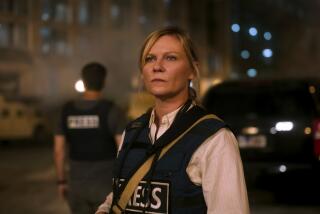Life wrecked by war
- Share via
On Sept. 13, 2001, after watching footage of President Bush brandishing his bullhorn atop the rubble of the World Trade Center, Tomas Young, a 22-year-old from Kansas City, Mo., enlisted in the Army. He thought he’d be sent to Afghanistan to smoke the evildoers out of their caves, as had been suggested. Instead, after completing his basic training at Ft. Hood, Texas, he was shipped to Iraq where, five days later, he was shot through the spinal cord and paralyzed from the chest down while riding through Sadr City in an un-armored, uncovered Humvee.
Produced and directed by former talk show host Phil Donahue and Ellen Spiro, “Body of War” is the story of Young’s political awakening in the aftermath of his experience, set against shifting politics and a growing awareness of the machinations that led to the war. Donahue and Spiro capture the stark contrast between the noble impulses of ordinary people such as Young, his fiancee, Brie, and his mother, Cathy, and the actions of the the U.S. House, Senate and Bush administration by letting them play out in alternating scenes.
We learn how Young signed up in a rush of patriotism and was followed by his younger brother; how Brie, having known him briefly before he shipped out to Iraq, resolved to marry him and become his full-time caretaker; how his mother cared for him while he was at Walter Reed Army Medical Center and whose activism on behalf of her son led to his story being told.
Young joins a group called Iraq Veterans Against the War and spends his honeymoon in Crawford, Texas, during a vigil led by Cindy Sheehan, whose son was killed in Iraq. He meets a paralyzed Vietnam War veteran who is shocked to discover that Young’s injuries, similar to his own, resulted in half the hospital stay and physical therapy that he received. Young struggles with the daily rigors of life in a wheelchair. Nerve pain, depression, incontinence, chronic urinary tract infections and impotence are daily realities, which the film cuts together with C-SPAN footage of the deliberations on the House and Senate floors, where congressmen and senators echo the president’s assertions without altering sentences or choosing different metaphors. (“The smoking gun” and “a mushroom cloud” are favorites.)
What’s striking about the footage of the march up to war -- and who’d have thought you could ever call C-SPAN footage striking -- is the rushed, hollow, echoed tone the rhetoric takes and how quickly and inexorably the resolution to authorize the use of force in Iraq is passed despite the measured, impassioned objections of 23 people, including Sen. Robert Byrd (D-W.Va.). Donahue and Spiro methodically contrast the rushed and cursory decision with the lifelong consequences people like Young face, and slightly heavy-handed as it is, it couldn’t make for a more damning before and after.
Like so many recent documentaries on the Iraq war, “Body of War” makes no bones about its activism. Then again, like the others, it’s the willingness to contextualize events and apply reason to them that makes it and others so valuable. Still, politics recede in the face of the realities of Young’s life, and Spiro and Donahue would have succeeded in making the same point had they omitted all but his day-to-day existence. Together, however, they comprise a powerful indictment of the tactical politics that led to the invasion and a heartbreaking account of one man’s living with the aftermath.
--
--
“Body of War.” Unrated. Run time: 1 hour, 27 minutes. In limited release.
More to Read
Only good movies
Get the Indie Focus newsletter, Mark Olsen's weekly guide to the world of cinema.
You may occasionally receive promotional content from the Los Angeles Times.








